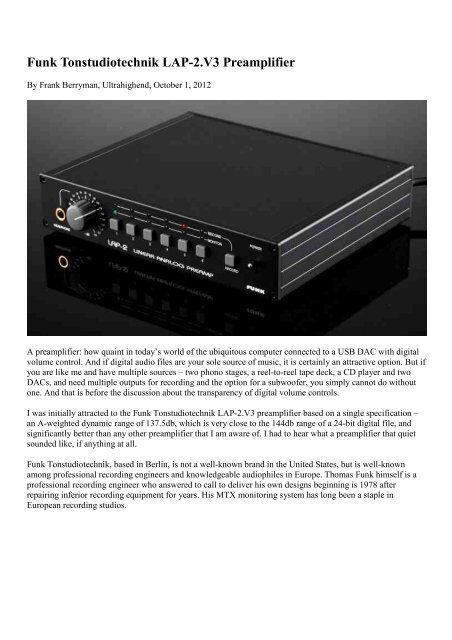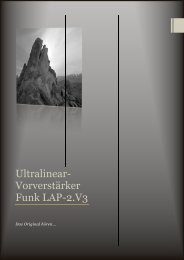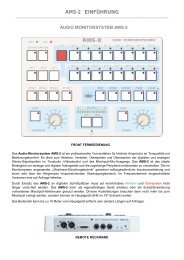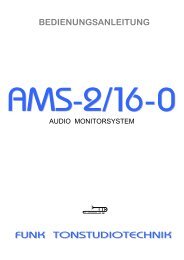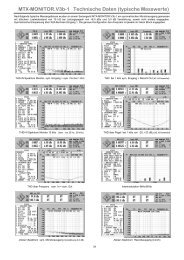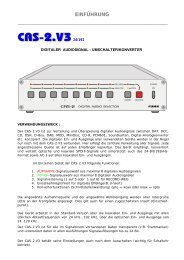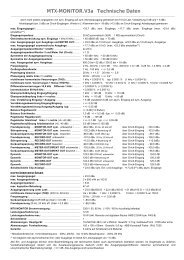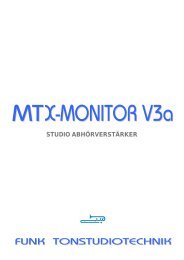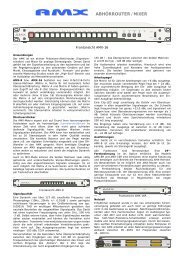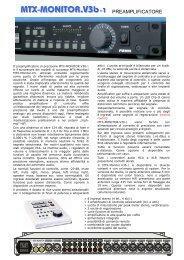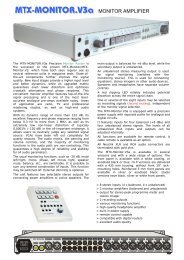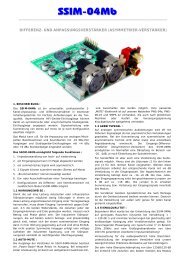funk_lap2v3_review Frank Berryman - Funk Tonstudiotechnik
funk_lap2v3_review Frank Berryman - Funk Tonstudiotechnik
funk_lap2v3_review Frank Berryman - Funk Tonstudiotechnik
You also want an ePaper? Increase the reach of your titles
YUMPU automatically turns print PDFs into web optimized ePapers that Google loves.
<strong>Funk</strong> <strong>Tonstudiotechnik</strong> LAP-2.V3 Preamplifier<br />
By <strong>Frank</strong> <strong>Berryman</strong>, Ultrahighend, October 1, 2012<br />
A preamplifier: how quaint in today’s world of the ubiquitous computer connected to a USB DAC with digital<br />
volume control. And if digital audio files are your sole source of music, it is certainly an attractive option. But if<br />
you are like me and have multiple sources – two phono stages, a reel-to-reel tape deck, a CD player and two<br />
DACs, and need multiple outputs for recording and the option for a subwoofer, you simply cannot do without<br />
one. And that is before the discussion about the transparency of digital volume controls.<br />
I was initially attracted to the <strong>Funk</strong> <strong>Tonstudiotechnik</strong> LAP-2.V3 preamplifier based on a single specification –<br />
an A-weighted dynamic range of 137.5db, which is very close to the 144db range of a 24-bit digital file, and<br />
significantly better than any other preamplifier that I am aware of. I had to hear what a preamplifier that quiet<br />
sounded like, if anything at all.<br />
<strong>Funk</strong> <strong>Tonstudiotechnik</strong>, based in Berlin, is not a well-known brand in the United States, but is well-known<br />
among professional recording engineers and knowledgeable audiophiles in Europe. Thomas <strong>Funk</strong> himself is a<br />
professional recording engineer who answered to call to deliver his own designs beginning is 1978 after<br />
repairing inferior recording equipment for years. His MTX monitoring system has long been a staple in<br />
European recording studios.
The first thing you notice about the LAP-2.V3 is its diminutive size. It occupies a mere one-half of a standard<br />
1U rack mount space. The front panel is replete with a 21 step volume control, buttons for the six inputs and for<br />
selecting the source to record from, a ¼” headphone jack, and a power switch. The rear panel is busy, but<br />
symmetrically laid out. Twelve sets of gold-plated RCA jacks are available for the six inputs, two parallel<br />
outputs for a power amplifier or active speakers and a subwoofer, and four parallel outputs for recording<br />
devices, more than needed for most audiophiles but just sufficient for professional mastering use. All inputs and<br />
outputs are unbalanced. Cramming all of that functionality into such a small form-factor was only accomplished<br />
by using a carefully laid out short-trace circuit board and surface-mount components.
Front panel operation is straight-forward. Input is selected by pressing the corresponding electronically<br />
controlled source selection button. A green LED indicates which source is selected for monitoring. Mute is<br />
accomplished by pressing and holding down the source button for at least once second. When mute is engaged,<br />
the green LED dims. You select the source to send to the four parallel record outputs by holding down the red<br />
Record button and pressing one of the source input buttons. A red LED indicates which source is selected for<br />
recording. The sensitivity of the inputs, and even the brightness of the LEDs, are user adjustable from within the<br />
unit. Shown below is a schematic of the input/output options. Although it may look complicated, such<br />
flexibility does not come at the cost of a non-intuitive interface. It’s a snap to operate.
I have been listening to Bonnie Raitt’s new album Slipstream quite a bit of late. There are a couple of cuts I use<br />
as a reference. Right Down the Line has a driving bass line punctuated by a kick drum. Neither requires<br />
exceptionally low frequency extension, but they do require a fast, articulate response which the LAP-2.V3<br />
provides in spades. In addition, the snare is very crisp, and you can clearly hear the texture of the skin of the<br />
head. The sparse strings of electric guitar, particularly the grace notes, are finely delineated, with an extended<br />
decay when played as such. Bonnie’s vocals stand out starkly from the rest of the instruments which surround<br />
her, creating a pinpoint soundstage. All of this results in large measure from the quietness of the LAP-2.V3 and<br />
its transparency. In Not Cause I Wanted To, instrumentation is spare, limited to electric bass, acoustic guitar,<br />
and keyboards faintly in the background. Unexpected for such a neutral preamp, the acoustic guitar has a full,<br />
even warm sound. I am certain this is a result of the recording engineers selection of mics and EQ, and not<br />
euphony added by the LAP-2.V3. Though there are plenty of opportunities, Bonnie’s voice is reproduced<br />
without sibilance.
Shifting genres, I put on Sara K.’s audiophile classic Closer Than They Appear. In Miles Away, the bass is more<br />
prominent than in Bonnie Raitt’s Not Cause I Wanted To, but it is just as fast and articulate. There is a marked<br />
difference in tone, though, because it is an acoustic rather than electric bass. The finger pluck is quite distinct.<br />
The occasion bell rings out clearly from seemingly nowhere. Brushes on the cymbal have their characteristic<br />
metallic swish, though that quality is not emphasized. On Jasmine, the bass has a very full sound. Shakers are<br />
clearly audible behind and slightly above the vocals. Bass overwhelms the hammer dulcimer, and substantially<br />
robs its characteristic sound. No fault of the LAP-2.V3 though. As a side note, I played this album at a volume<br />
of 68 rather than at 58 where I played Bonnie Raitt’s Slipstream. Although Slipstream is extremely well<br />
recorded, it is also significantly louder. A sign of the times.<br />
Piano is always a challenge to reproduce. Feeling nostalgic, I put on Keith Jarrett’s The Koln Concert. It is<br />
readily apparent that this is a live recording as the LAP-2V.3 retrieves all of the low-level ambient background<br />
noise. The piano sound is huge, with the recording microphones capturing the sound from very close to or<br />
inside the piano. In achieving its enveloping sound, the piano does not seem unnaturally large though, just a<br />
very close, forward and exciting sounding presentation. The LAP-2.V3 is clearly up to the task of reproducing<br />
the dynamics of the recording. Sustain notes go on and on, rather than abruptly fading into a noise floor. It<br />
sounds nothing like it did in the 1970′s on my hi-fi…thankfully.
I also put it through the paces as a headphone amplifier and was amazed. I plugged in my Etymotic ER-4 in-ear<br />
headphones, selected my Wadia 121 DAC and, with no music playing, turned the volume up all the way. I<br />
could hear no noise of any kind, just deathly silence. I dialed the volume back down, began playing music, and<br />
gradually turned the volume up. The LAP-2.V3 provides more than enough gain for the hard-to-drive ER-4s.<br />
What emerged from an absolutely black background was sound that was extremely transparent, neutral and<br />
dynamic. Details that were just audible through loudspeakers took on an exceptional clarity through<br />
headphones, though I would not characterize the sound as clinical. Headphone listening alone provides a raison<br />
d’etre for the LAP-2.V3.<br />
The only shortcoming or the LAP-2.V3 I could identify is that does not directly accept balanced inputs and does<br />
not directly offer balanced outputs, which may limit its appeal to audiophiles as well as professional recording<br />
engineers in the US. For those wanting balanced operation, <strong>Funk</strong> Tonstudiotechik does, however, provide<br />
several balancing/differential amplifier systems which can be used in conjunction with the LAP-2V.3 to provide<br />
true balanced inputs and outputs.<br />
Conclusion<br />
The LAP-2.V3 provides more flexibility than you are likely to ever need is a small, beautifully crafted chassis<br />
with elegantly simple operation. It is completely silent, neutral, and transparent. If you are looking for a<br />
preamplifier with personality, particularly something to warm up and round off the sound of your other<br />
components or loudspeakers, you’ll need to look elsewhere. As an added bonus, the front faceplate of the LAP-<br />
2.V3 is available in black, white, blue, dark red, silver and gold, as well as polished brass, gold plated or<br />
chrome plated. Both your eyes and ears are rewarded. Even if you have no need for multiple inputs and outputs,<br />
as a headphone amplifier, it is killer. The LAP-2.V3 is in all respects a jewel at a bargain price. At just €840 +<br />
VAT (~$1100), it is an easy recommendation.<br />
- <strong>Frank</strong> <strong>Berryman</strong><br />
Contact Information<br />
<strong>Funk</strong> <strong>Tonstudiotechnik</strong><br />
Pfuelstrasse 1a<br />
Berlin 10997 Germany<br />
Telephone: 0049 (0) 30 38106174<br />
www.<strong>funk</strong>-tonstudiotechnik.de<br />
<strong>funk</strong>@<strong>funk</strong>-tonstudiotechnik.de
Associated Equipment<br />
Analog Source: VPI Scout; Dynavector 20X2; Musical Surroundings Phonomena II; Otari MX-5050BII-2<br />
Digital Source: Meridian G08; Mac Mini; Wadia 121; Halide Design Bridge and DAC HD; Amarra and Pure<br />
Music<br />
Preamplifier: Meridian G02; Meridian G68ADV<br />
Power Amplifier: Krell Evolution 302e; Meridian 557<br />
Loudspeakers: Magnepan 1.7; Meridian DSP5500; YG Acoustics Carmel<br />
Cables: Analog: Kimber KS1016, KS1116; Speaker: Kimber KS6063, KS9033; Power: Kimber PK10G<br />
Accessories: GIK acoustic treatments; dedicated 20 amp circuit; Audience aR2p power conditioner


